An important aspect of strength and resistance training is progressively increasing load, intensity, or duration in order to increase strength, hypertrophy and adapt to demands. If you have been doing resistance-based exercises for several weeks now (see Part 1) and are noticing improvement in your ability to complete the recommended set and reps it may be time to start adapting the foundational exercises in part 1 to more dynamic movements to challenge the key muscle groups for increased strength, endurance, posture, and stability with loading.
Important Strengthening Exercises
Lateral Side Step With Band
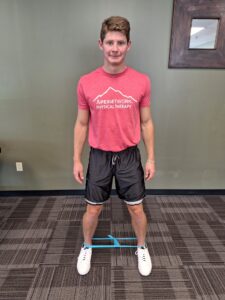
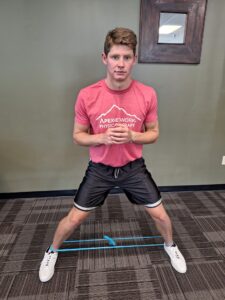
Start with a band around either knees or ankles (ankles slightly more challenging). Begin with a slight bend in your knees and a slight bend at your hips. Try to take small steps sideways. As you step sideways, try to pick up the leg and shift your body weight over the leg prior to putting the foot on the ground. Try not to take too wide of a step as this may cause too much hip internal rotation or medial knee rotation. Take about 15-25 steps to the right or left and repeat 3- 5x each direction.
This exercise works our hip abductors and lateral rotators. Even though running is largely a forward propelled motion, the control of performing single leg loading and push off largely comes from the hip rotator’s ability to control the pelvis as the leg accepts load. Strengthening in the frontal plane, as this exercise does, helps also control excessive hip rotation, which is important in endurance running to avoid lower extremity injuries.
Reverse Dead Lift with Dumbbells
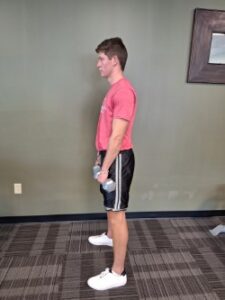
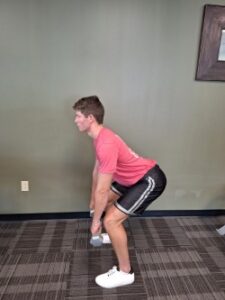
Stand while holding dumbbell in each hand at the front of thighs. Lean forward keeping your back straight and hinge through your hips so that the weight moves down, close to your legs until approximately mid-tibia height. Then, return to upright position. Be sure to keep dumbbells close to your body to avoid excessive pressure on your back. Repeat 3-5 sets of 8-10 reps.
The benefit of this exercise will be increasing strength in gluteals, quads, low back extensors and also increase hip stability and push off. This exercise also emphasizes the hip hinge, which will reinforce good running form as a forward trunk lean and hip hinge is beneficial for sustaining efficiency for running.
Single Leg Split Squat
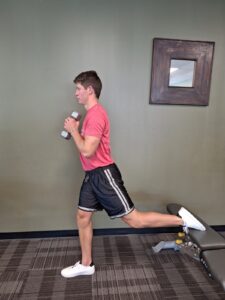

Begin with one foot propped up on a chair or other low object behind you as shown. Next, bend your knee and lower your body towards the floor. Return to a standing position. The forward knee should bend in line with the 2nd toe and not pass the front of the foot. Repeat 2-3 sets of 8-10 reps on each leg. The benefit of doing a single leg split squat will enhance motor control and single leg stability as most of running is unilateral loading. This will also help with injury prevention as unilateral movements prevent compensation while running.
Dumbbell Squat
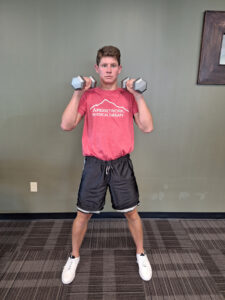

Stand with feet a little wider than shoulder-width apart. Hold a dumbbell in each hand and bend your elbows to hold the weights near your shoulders. You may have a slight lean forward but keep your back straight and do not allow it to round forward. Hinge and bend through your hips and knees and lower your body towards the floor to perform a squat. Your body weight should mostly be directed through the heels of your feet and knees should bend in line with the 2nd toe and not pass beyond the toes.
Repeat 3 sets of 8-10 reps.
Farmers Carry

Hold moderately heavy load in one hand, approx. 15-30lb kettlebell or free weight at your side. Walk 20 feet, turn, and then walk 20 feet back to starting point. Maintain an erect and straight spine, do not allow shoulder or pelvis to tilt toward the weighted side. Maintain tone in your shoulder to support the weight. Perform 2-3 sets on each arm. While this movement may seem simple it is very effective for working your entire core, trunk stability and focus on good cadence, proper foot strike and even simultaneously work on breathing in order to connect your entire kinetic chain.
Single Leg Ball Toss on Dynamic Surface


Stand on top of a balance pad, pillow, seat cushion, or other unstable surface. Balance on one leg and stand so that a wall is in front of you. Toss a ball against the wall and catch it while maintaining your balance. Try toss forward and maintain balance for 10 tosses. Repeat 2-3 sets each leg.
While standing with one foot on dynamic surface, throw and catch a ball maintaining your balance. Keep your knees slightly bent to approximately 30 degrees while performing this exercise. Load your stance leg hip as your rotate torso and toss toward target. Maintain balance as you catch the ball off the wall/ or from partner then rotate trunk to opposite. Repeat 10 tosses to each side. If you lose your balance, you can touch your toes down and or take a step if needed.
Try to perform these exercise 2-3 x per week. They will supplement the training load while improving motor control, posture, hip and core stability, and allow for strength progression.
WRITTEN BY: Angela Dirnbeck PT, DPT, CMPT.
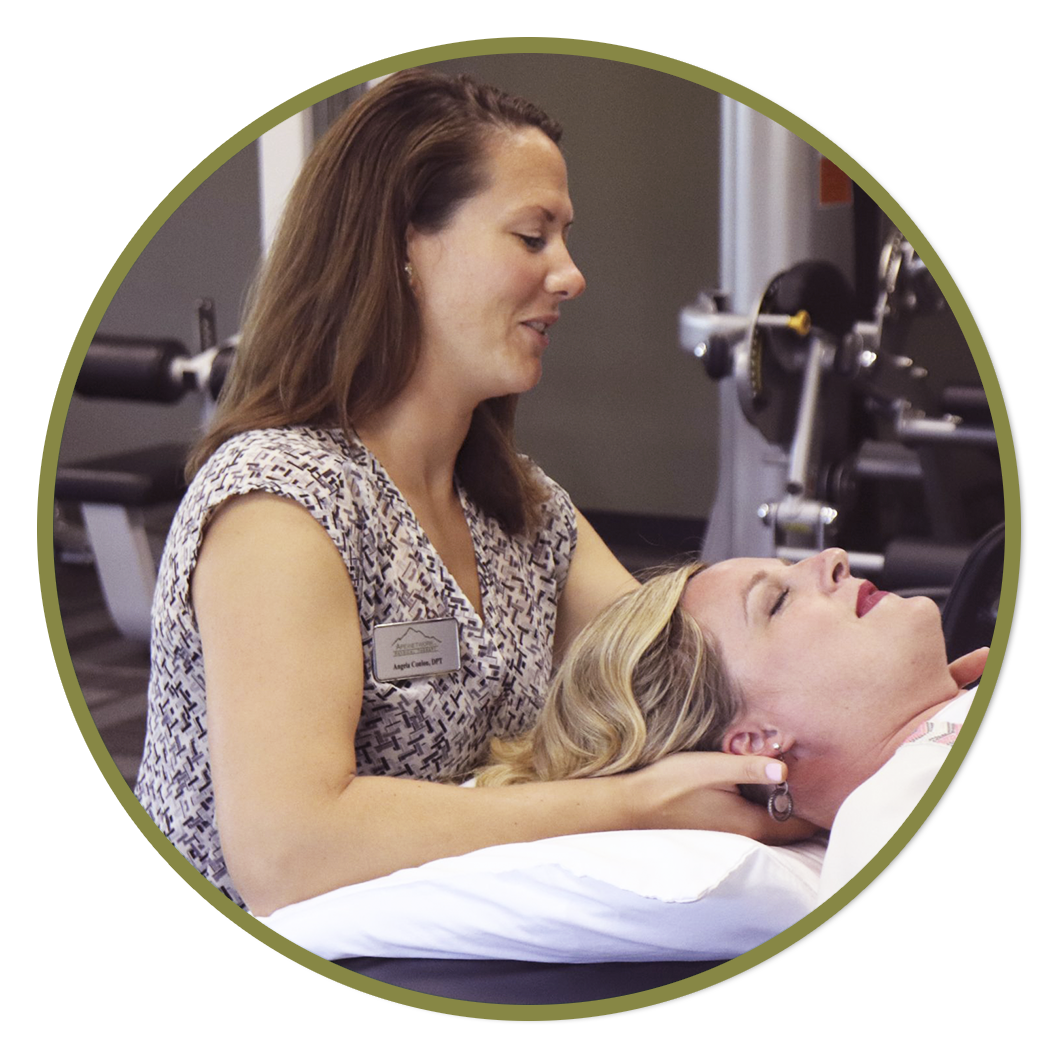 BIO: Angela is a Physical Therapist and clinic manager at the Chesterfield ApexNetwork location in Chesterfield, MO. She graduated in 2013 with her Doctor of Physical Therapy from Des Moines University. She has extensive training in manual therapy and a certification from the North American Institute of Orthopedic Manual Therapy (NAIOMT) and has been with ApexNetwork for almost 10 years and enjoys treating a variety of orthopedic and musculoskeletal injuries, including runners and endurance athletes. Angela has a comprehensive understanding of injury prevention and treatment being a distance runner herself for > 20 years. She competed as an NCAA D1 athlete in cross country and track for the University of Dayton. Following undergraduate competition she began running half marathon and full marathon distances, completing 4 marathons, 2 of which were the Boston Marathon. Over her years of practice, she has incorporated a lot of her experience and knowledge into treatment and patient care and has helped many patients and athletes rehabilitate and teach biomechanics for greater awareness of injury prevention and return to sport.
BIO: Angela is a Physical Therapist and clinic manager at the Chesterfield ApexNetwork location in Chesterfield, MO. She graduated in 2013 with her Doctor of Physical Therapy from Des Moines University. She has extensive training in manual therapy and a certification from the North American Institute of Orthopedic Manual Therapy (NAIOMT) and has been with ApexNetwork for almost 10 years and enjoys treating a variety of orthopedic and musculoskeletal injuries, including runners and endurance athletes. Angela has a comprehensive understanding of injury prevention and treatment being a distance runner herself for > 20 years. She competed as an NCAA D1 athlete in cross country and track for the University of Dayton. Following undergraduate competition she began running half marathon and full marathon distances, completing 4 marathons, 2 of which were the Boston Marathon. Over her years of practice, she has incorporated a lot of her experience and knowledge into treatment and patient care and has helped many patients and athletes rehabilitate and teach biomechanics for greater awareness of injury prevention and return to sport.



